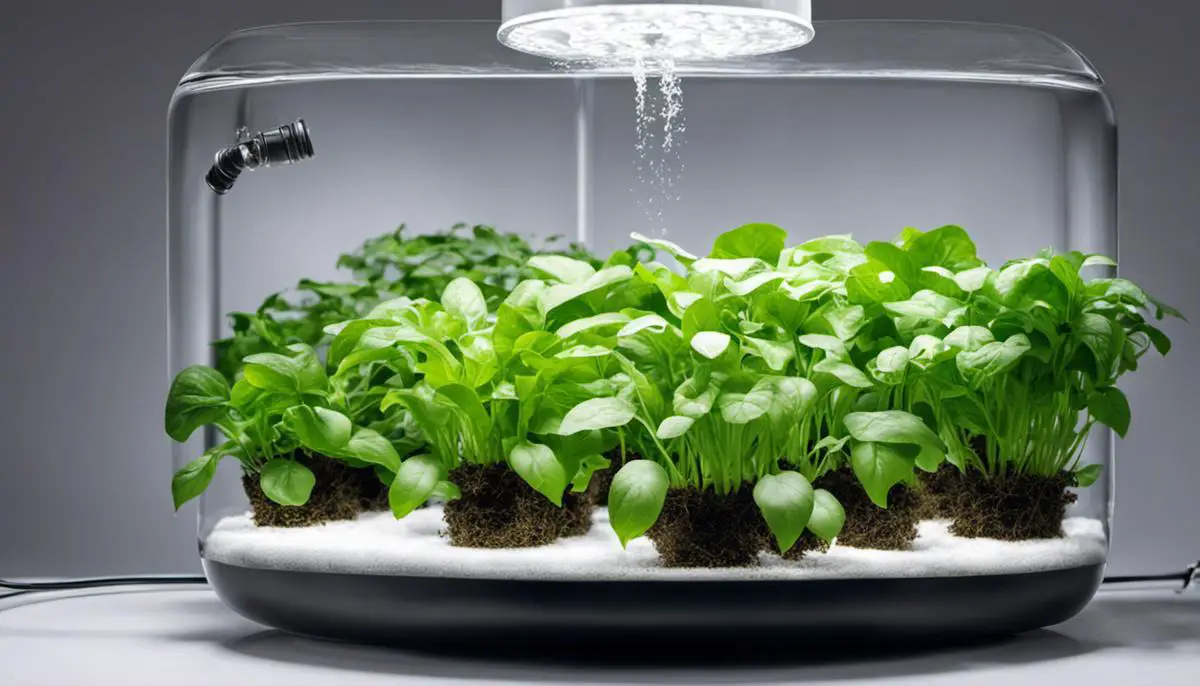When envisioning a garden, one typically imagines plant roots firmly entrenched in the soil, drawing nourishment from the ground. However, soil-less gardening, or hydroponics, dispels this traditional notion, proving that plants can thrive in a water-based environment teeming with essential nutrients. In particular, lettuce, a mainstay in many gardens and kitchens, is one crop that benefits greatly from this unique style of cultivation. This exploration into the world of hydroponics will enlighten you about this plant-friendly, chemical-nutrient-using, lets-grow-lettuce-without-soil approach. Further, the importance of proper setup and maintenance of a hydroponic system for successful lettuce growth will be delved into, alongside practical troubleshooting tips to help ensure a bountiful yield.
Understanding Hydroponics
Discover the Joy of Hydroponics: The Perfect Method for Growing Lettuce!
Every gardening enthusiast, at some point in their journey, craves for ways to garden that are both space-conducive and efficient. Enter the world of hydroponics! It’s an enjoyable, fascinating, and incredibly effective method of gardening that is suiting to both beginners and seasoned green thumbs. As soon-to-be hydroponic gardening aficionados will learn, lettuce is an ideal candidate for this method, making a nice, crisp and rewarding introductory crop.
Reader Poll: What online courses would interest you?
So, what is hydroponics and what makes it robustly effective? Simply put, hydroponics is the science of growing plants without soil, usually in a water solution with added nutrients. In hydroponic systems, plants grow faster, yield more, and can be grown year-round, all while using less space and water than traditional gardening.
Hydroponics takes out the guesswork from soil gardening. By controlling the nutrients directly, gardeners can provide the exact nutrient balance needed, ensuring a healthy, robust plant. No soil-borne diseases to worry over, no weeding, and the convenience of indoor gardening are just a few of the benefits that make hydroponics such a compelling practice.
So, why does lettuce thrive in hydroponic systems? First, lettuce is a short-term, fast-growing crop, with most varieties maturing in 30-45 days, making it an excellent candidate for hydroponics. Second, lettuce demands less light compared to other crops, making it easily adaptable to indoor settings. Lastly, lettuces’ relatively compact size makes them ideal for hydroponic systems, where space management is always a priority.
Subscribe to our newsletter!
Subsequently, it is not surprising that the commercial cultivation of lettuce has embraced hydroponics wholeheartedly. To take a leaf (pun intended!) out of the commercial book, here are a few tips for lettuce cultivation, hydroponic style:
- Choosing the right lettuce variety: Some lettuce varieties are simply better adapted to hydroponic systems. Varieties such as Romaine, Butterhead, and Batavia do particularly well.
- Lighting requirements: Keeping your hydroponic system near a window with ample sunlight is a good idea. If unavailable, artificial lights for around 14-16 hours a day will do the trick.
- Nutrient solution: Providing a balanced nutrient solution specifically designed for leafy greens will help optimize the lettuce growth.
- Temperature control: Lettuce prefers cooler temperatures. Ideally, keep the environment around 70-75 degrees Fahrenheit during the day and 50-60 degrees Fahrenheit during the night.
Hydroponic gardening is truly a hobby that keeps on giving! The joy of watching lettuce go from seed to salad in just over a month is immense and infinitely satisfying. More than that, it’s a way to embrace innovation, efficiency, and sustainability, cultivating not just lettuce, but also a new, exciting wave of gardening! Add the crunch of home-grown lettuce to that salad today by diving into the world of hydroponics!
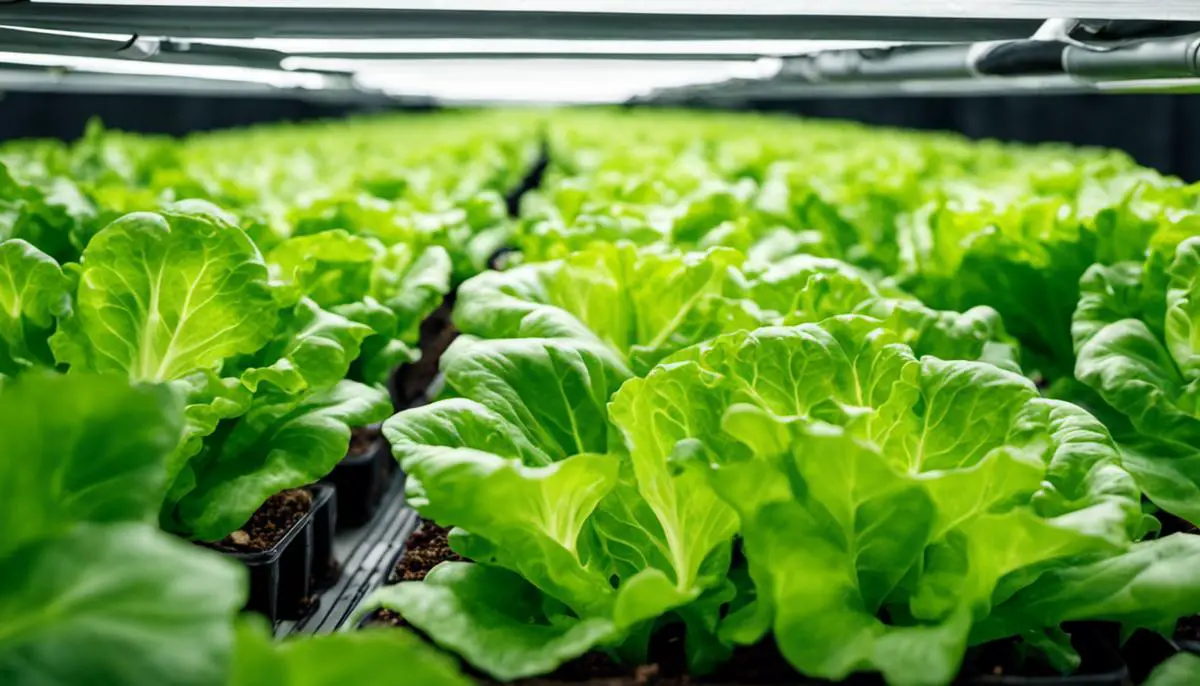
Components of a Hydroponic System
Diving into the nitty-gritty of hydroponic gardening, let’s explore the key components of an effective hydroponic system for lettuce production and how these elements work together harmoniously.
The Base:
Structurally, every hydroponics system begins with a solid base where the plants are housed. Drained of soil, the roots of the lettuce plants are typically supported by inert materials such as rockwool, clay pellets, or coconut coir. This base not only provides physical support but also increases oxygenation, essential for root health.
The Reservoir:
The watery cradle of the hydroponic system is its reservoir. This is where the nutrient solution – an elixir of perfectly balanced plant nutrients – is held. The roots of the lettuce immerge into this solution, from where they extract sustenance.
The Nutrient Solution:
Akin to the plant’s meal, the nutrient solution is a crucial component in hydroponics. It consists of water together with essential minerals that lettuce needs for growth. This includes macronutrients such as nitrogen, potassium, and phosphorus, as well as micronutrients like iron, manganese, zinc, and several others.
The Pump:
The heart of the system is the pump which ensures the nutrient solution circulates regularly from the reservoir to the plant base. It maintains relentless vigilance to prevent the roots from drying out and ensures every lettuce cell is enriched by the nutrient solution.
The Air Stones:
Think of Air Stones as the lungs of the hydroponic system. Usually submerged in the reservoir, Air Stones pump bubbles of air into the nutrient solution, ensuring the roots have ample oxygen supply.
The Lighting System:
Mimicking the sun’s part in traditional gardening, the lighting system plays an integral role in hydroponics. It gives lettuce the photo-energy needed for photosynthesis. LED lights are favored due to their energy efficiency and spectrum customizability.
The Environmental Controller:
This critical system governs the living conditions of the lettuce. Factors like humidity, temperature, light levels, pH, and nutrient strength are all managed here. Providing a consistent, optimized environment is key for stellar hydroponic lettuce growth.
Each component of the hydroponic system for lettuce production is as crucial as it could get. Importantly, they function together, as a well-oiled machine, each supplying a vital piece of the puzzle integral to the thriving of lettuce.
Finding the right balance and synergy between these components is the secret sauce to growing a healthy, bearable harvest. Nevertheless, nothing outweighs the diligence and patience of the gardener, who with their innate love, brings about a bouquet of bright, crisp lettuce ready to shape into a delightful meal.
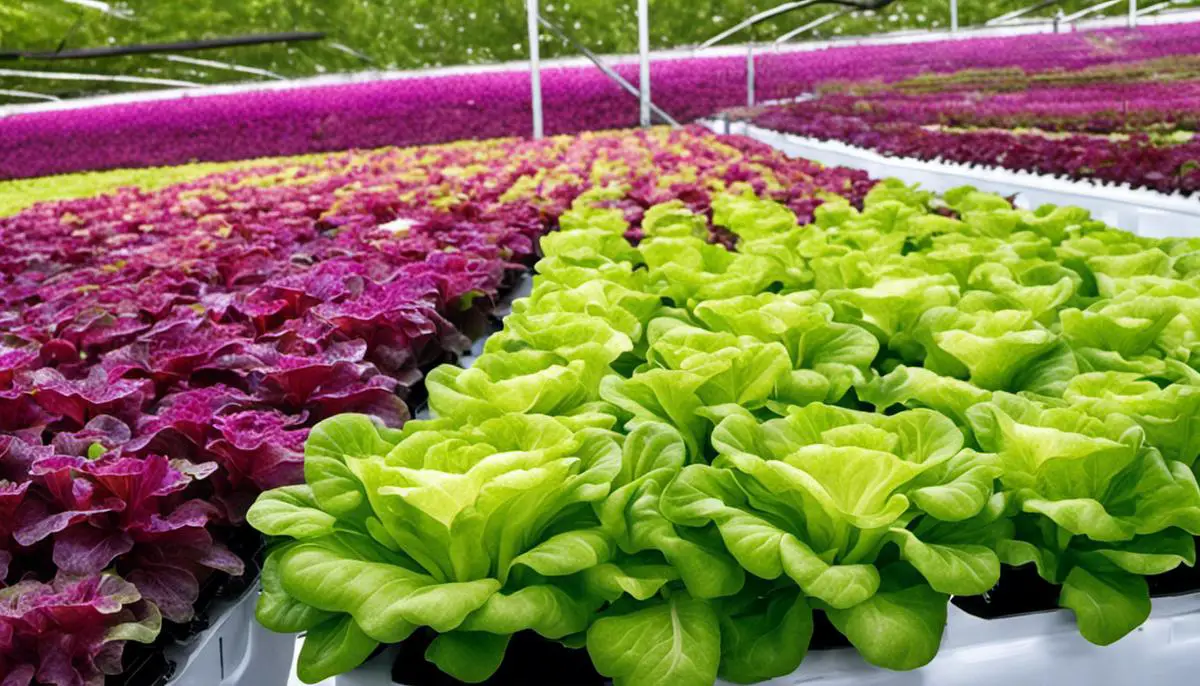
The Hydroponic Lettuce Growing Process
Now, let’s delve into the exciting journey of germination in a hydroponics setup!
Starting lettuce from seeds is quite straightforward. First, procure good quality lettuce seeds. Then, the seeds are sowed into propagation cubes made of a fibrous material like rockwool, which does an excellent job at retaining water. Patience is key here, as it typically takes around 2-10 days for lettuce seeds to germinate, provided they are kept in a relatively warm place, ideally between 70-80°F.
Once seedlings sprout, light becomes a prerequisite. At this stage, a common mistake to avoid is placing the fledgling seedlings too close to the lights – they need light but avoid excess heat. Let the seedlings bask around 10-14 hours of light daily, especially during the initial periods when the seedlings are still trying to establish themselves.
Around 2-3 weeks post-germination, the seedlings are usually robust enough to be transferred to the hydroponic system. Simultaneously, it’s time to introduce our tiny green friends to nutrient-rich water, the keystone of hydroponic cultivation. Ensure that the seedlings are gently secured in net pots, with their roots exposed to the nutrient solution below.
The fascinating process of growth now happens most vividly, with lettuce leaves proliferating rapidly. But the hobbyist’s job isn’t done yet! Monitoring the pH level of the nutrient solution during this growth phase is crucial; an ideal range is between 5.5 and 6.5. A deviation here could lead to sub-optimal growth or even nutrient deficiency, indicating why consistency in hydroponics is often a mark of experience.
Keeping an eye on the temperature of the water is necessary too – lettuce roots love a cool environment. A water temperature range of 60-70°F is often optimal. Remember, overtly warm water can encourage the growth of harmful bacteria, which our hydroponic lettuce wouldn’t fancy!
Now, with everything in check, the lettuce plants grow full swing. The gardener’s sweetest reward is almost here; harvesting! Hydroponic lettuce is usually ready for harvesting in a month. The rule here is simple – if the lettuce looks mature and appetizing, it’s ready. And the best part? The lettuce can be harvested repeatedly, especially until the temperature does not exceed 75°F for leaf lettuces.
So there it is, folks, your very own bounty of hydroponic lettuce, from seed to salad! It might seem quite intricate at first, but remember, every rewarding hobby comes with its protocols and quirks. And the joy of having a salad from lettuce you’ve grown—now that’s something indescribably delightful!
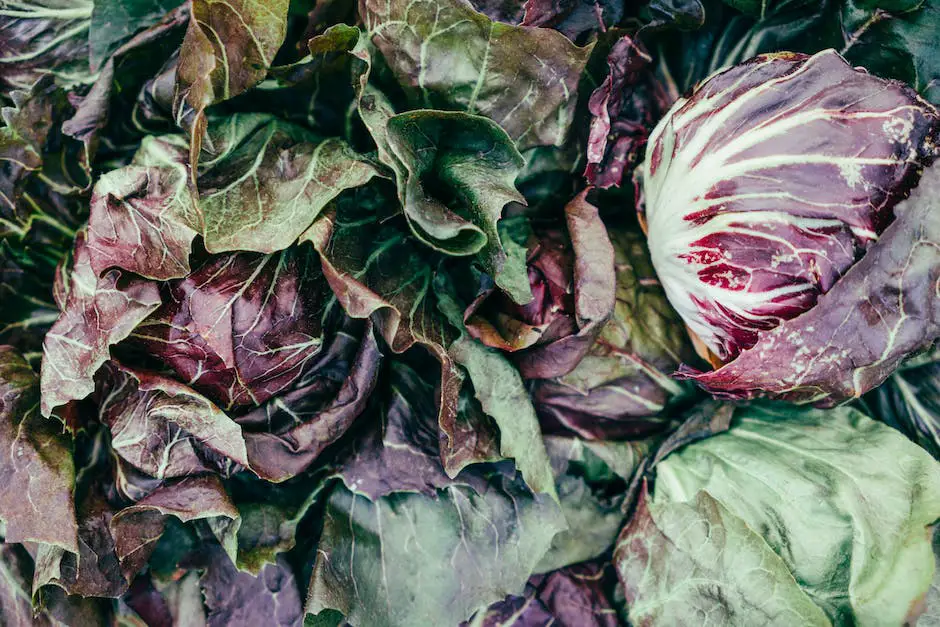
Hydroponic System Maintenance and Troubleshooting
As joyous and rewarding as hydroponic lettuce gardening is, it’s indisputable that maintenance of the system and troubleshooting any inherent issues are elements that demand keen attention. Emphasizing vigilance, preciseness, and adeptness, the care of this unique gardening system calls for consistent checks and balances that determine the overall success of lettuce growth.
A primary task is the continuous monitoring of the nutrient solution that fuels lettuce growth in the hydroponic environment. Testing the pH level of the nutrient solution is necessary at least once a week. The pH should ideally be within a range of 5.5 to 6.5. Regular controller pH meters available in the market are convenient tools for this task. If the pH is outside these parameters, pH adjusters can be used to restore balance.
Maintaining the right water temperature is equally essential. Water temperature affects not only nutrient absorption but also the levels of dissolved oxygen, which is vital for root health. The optimal range is between 65 to 70°F (18 to 21°C). A water thermometer is an effective tool for tracking water temperature, while water chillers or heaters can help regulate it effectively.
The hydroponic system needs regular cleaning to avoid unwanted algae, root disease, or insect infestations. It’s advisable to do a complete system cleanse between crop cycles. It involves flushing out old nutrient solutions, cleaning the components with peroxide-based cleaners, and rinsing everything before adding fresh nutrient solution.
Reservoir changes are recommended every two weeks. This periodic renewal gives the system a fresh start, helps maintain an optimal nutrient balance, and prevents any nutrient waste accumulation. The gardener can use this opportunity to check the pump, air stones, and any other components for proper functionality.
Monitoring plants regularly for any signs of stress or disease is a must. Wilted leaves, discoloration, or curling are usually signs of nutrient deficiency or pest infestations, and need immediate attention.
Lighting in a hydroponic garden plays a significant role, and its importance cannot be understated. The lighting system has to be adjusted as the plants grow, to ensure they get adequate light without risk of scorching or overheating. Techniques like interplanting, where taller plants can provide shade for those that require less light, can also be utilized to manage lighting effectively.
Whether lettuce growth issues are due to pH imbalance, water temperature, nutrient deficiency, inadequate lighting, or pest problems, it’s essential to remember that patience and persistence are the two pillars that will guide any hydroponics hobbyist towards success. Every issue is a learning experience, and every solution brings us closer to nurturing thriving, succulent, and crisp hydroponic lettuce—the cornerstone of any fresh and healthy salad!
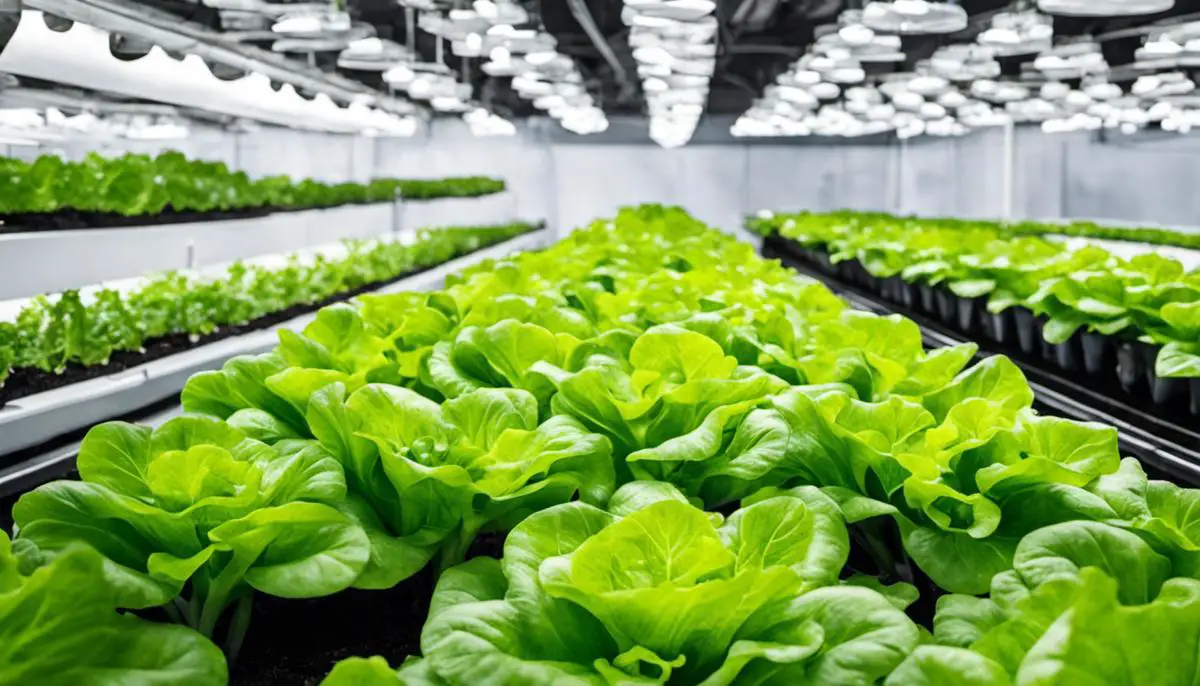
There’s no denying that hydroponics is revolutionizing food production, and lettuce is only the tip of the iceberg. As the world grapples with issues of sustainability and combatting climate change, hydroponics offers a viable solution that promises space-saving techniques, resource conservation and has less detrimental impact on the environment. Armed with the necessary knowledge on the integral components of a hydroponic system, the growth process of hydroponic lettuce, as well as maintenance and troubleshooting techniques, anyone can undertake this environmentally friendly method of farming. Indeed, hydroponics opens up a world of possibilities, turning a traditional green thumb into an innovative aqua one.

